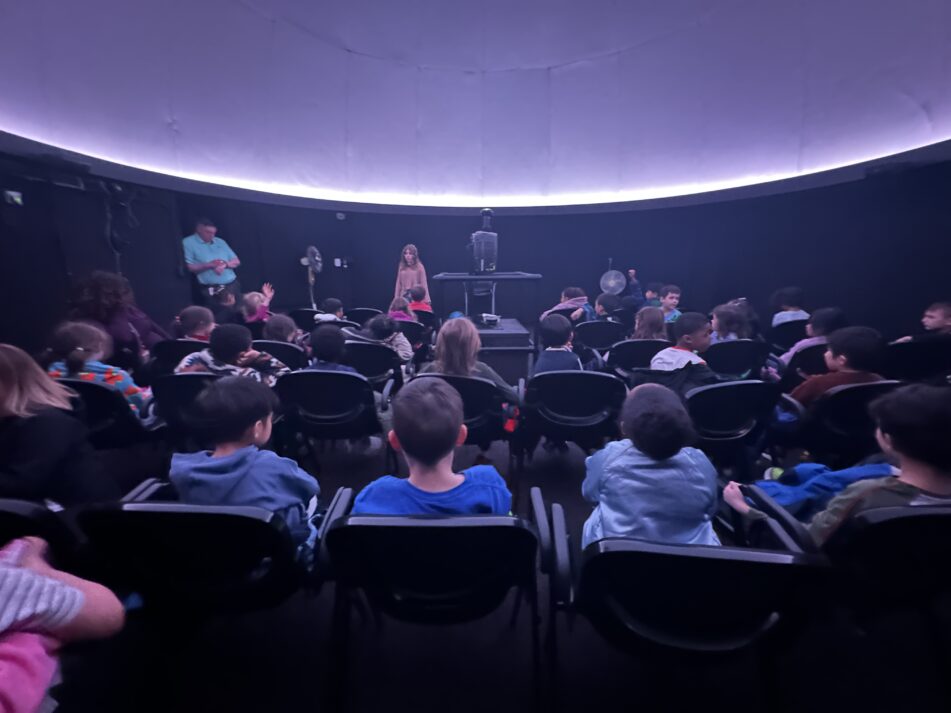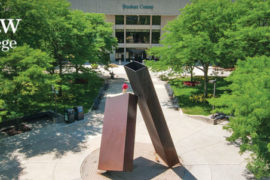For Ann Arbor Public Schools’ first and fifth graders, a field trip to the Argus Planetarium at Pioneer High School is a chance to have the wonders of the cosmos come alive before their eyes.
This longest continually operating high school planetarium in the nation has been sparking students’ interest in astronomy for decades.
Thurston first grade teacher Hannah Kerr said that she and her students thoroughly enjoyed their recent field trip to Argus, which is inconspicuously located across from Pioneer’s second-floor media center.
“This is a great field trip,” said Kerr. “First graders always get super excited about learning about space; it’s such a big idea. And this is such a great visual to go along with our curriculum that we talk about in the classroom. And the kids just love it.”
AAPS is using the planetarium now in collaboration with the University of Michigan’s Natural History Museum and its Planetarium Manager, Buddy Stark, says Tony Stamm, AAPS K-5 Mathematics and Science Curriculum Coordinator.
“For the past three years, Buddy has helped develop and put together special shows for our first and fifth grade students that are aligned with our district science curriculum,” says Stamm.
Around 70 planetarium shows are held at Argus each spring year just for AAPS students. The high-tech Digistar 6 projection system (made possible through a grant from Imra) allows students to virtually explore the night sky, witness the motions of the planets, and even travel through the galaxy—something difficult to achieve in normal classroom settings.
“When designing these shows, the primary aim is to reach the affective domain of students that can sometimes be difficult in more traditional classroom settings,” explains Stark. “It’s what is sometimes referred to as the ‘wow factor’ in informal education circles. We want them to internalize that astronomy and science in general are intrinsically fascinating and worthy of their attention.”
While the shows cover specific curricula content, the immersive visualization and storytelling allow abstract concepts to click for young learners, Stark said, citing the obvious example as daily and seasonable motions of the sky. Seeing the sun dramatically rise in the east and set in the west, or how its path shifts across the seasons, makes these fundamental astronomical ideas intuitive.
“We can demonstrate how each season impacts where the sun rises and how it travels higher or lower across the sky based on the time of the year,” he said. “These and many other sky-related topics become much more intuitive for people when compared to other more traditional methods.”
Allen Elementary fifth grade teacher Sara Wheat said her students enjoyed their recent trip to Argus, with one student saying: “It was out of this world!”
Logan fifth grade teacher Hiroyuki Totsuka took his students to Argus this week.
“My kids had a wonderful time learning about the seasonal constellations,” he said. “The lessons were engaging and the instructor was helpful with answering every question.”
The primary objective is to get students to internalize the idea that this topic, and science in general, is intrinsically fascinating and worthy of their time and attention, Stark said.
“That’s not to say that we aren’t covering specific content in the process,” he said. “One of the benefits of planetariums regarding astronomy is that you can visualize certain topics in more concrete ways than you can in a classroom, which can be very helpful in allowing students, especially younger students, to construct knowledge of these topics.”

Stark doesn’t know how many K12 planetariums are left and says it’s difficult to track as so many have shut down over the years. At the peak there were between 300-400 in the country, he said, but many are closed or repurposed spaces now. In Michigan, there are just a handful of operating K12 planetariums.
When the Argus Planetarium was installed in the new Ann Arbor High School in 1956 with a donation from the Argus Camera Company, it was the first high school planetarium in the country. John Rosemergy was the director until 1987, when Steve Schaffer took over until 2011 when Ron Robinson became director until 2021. Each had apprenticed for the previous director for many years and were good shepherds for the planetarium, Stamm said.
Another benefit of the partnership with U-M: AAPS eighth graders take field trips to Planetarium & Dome Theater at the U-M Museum of Natural History. The experiences between the U-M planetarium and the Argus planetarium are similar, Stark said, noting that both facilities operate on the same software, are approximately the same size at roughly a 10-meter dome, and feature similar seating arrangements.
“One of the benefits to the U-M planetarium is that we’re attached to a museum with some really amazing exhibits so visitors are able to multitask between getting their astronomy fix and their dinosaur fossil fix all in the same space,” Stark said. “One of the benefits of the Argus planetarium, at least for some of the students, is that it’s a location where they will one day be attending as a high school student, so they’re able to build some really nice nostalgia for spaces that become their own over time. I imagine from a district perspective there are also probably some ways that Argus eases the logistics of handling field trips when compared to a non-AAPS institution.”
Stark said the partnership is a mutually beneficial arrangement that’s working well on many fronts. “We’ve gotten a lot of very kind and positive feedback from the teachers who have visited Argus for these shows and we’re looking forward to continuing,” he said.







